
Scaevola is a genus of flowering plants in the Goodenia family, Goodeniaceae. It consists of more than 130 species, with the center of diversity being Australia and Polynesia. There are around 80 species in Australia, occurring throughout the continent, in a variety of habitats. Diversity is highest in the South West, where around 40 species are endemic.

Charles Gaudichaud-Beaupré was a French botanist.
Johann Friedrich Klotzsch was a German pharmacist and botanist.

Archontophoenix alexandrae, commonly known as Alexandra palm, king palm, Northern Bangalow palm, or feather palm, is a palm endemic to Queensland, Australia. It was named in honour of Princess Alexandra of Denmark, but is often erroneously referred to by the misnomer Alexander palm.

Kohautia is a genus of flowering plants in the family Rubiaceae. They are native to tropical areas of Asia, Africa, and Madagascar. Thirty-one species are known. The type species for the genus is Kohautia senegalensis.

Lessingia is a genus of plants in the family Asteraceae which are native to western North America. Several species are endemic to California.

Melaleuca orophila, commonly known as needle bottlebrush or Flinders Ranges bottlebrush, is a plant in the myrtle family, Myrtaceae and is endemic to the eastern part of South Australia.. It is a medium-sized shrub with sharp-pointed, needle-like leaves and bright red bottlebrush flower spikes.

Kadua is a genus of flowering plants in the family Rubiaceae. It comprises 29 species, all restricted to Polynesia. Twenty-two of these are endemic to the Hawaiian Islands. Some of the species are common at high elevation. Others are single-island endemics or very rare, and a few are probably extinct. Kadua affinis is widely distributed in Hawaii and is polymorphic. The type species for the genus is Kadua acuminata.
Buddleja stachyoides is the most widespread member of the genus in South America, endemic to woodland edges, roadsides and riversides in Argentina, Brazil, Bolivia, Paraguay, and Uruguay. Introduced to the UK as B. australis in 1822, when the Royal Botanic Garden Edinburgh grew it from seed received from a Russian source, the plant was described and renamed B. stachyoides by Chamisso & von Schlechtendal in 1827.
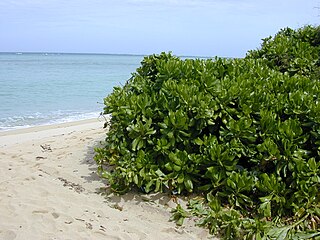
Scaevola taccada, also known as beach cabbage, sea lettuce, beach naupaka, naupaka kahakai (Hawaiian), magoo (Divehi), merambong (Malay), bapaceda or papatjeda, ngahu (Tongan) is a flowering plant in the family Goodeniaceae found in coastal locations in the tropical areas of the Indo-Pacific. It is a common beach shrub throughout the Arabian Sea, the tropical Indian Ocean and the tropical islands of the Pacific Ocean.

Arnica chamissonis, the Chamisso arnica, is a North American species of plants in the family Asteraceae. It is very similar to Arnica montana. Arnica chamissonis is native to North America and naturalized in parts of Europe while A. montana is indigenous to Europe.

Linnaea floribunda is a species of flowering plant in the honeysuckle family, Caprifoliaceae, native to Mexico. Growing to 4 m (13 ft) tall and broad, it is a semi-evergreen or evergreen shrub with shiny ovate leaves and clusters of tubular cerise flowers to 5 cm (2.0 in) long. Though hardy down to −10 °C (14 °F) it prefers a sheltered location, for instance against a south-facing stone wall.

Linnaea parvifolia, synonym Abelia schumannii, is a species of flowering plant in the family Caprifoliaceae, native to central China. It is a semi-evergreen shrub growing to 2 m (7 ft) tall by 3 m (10 ft) broad. Pink flowers with red calyces are produced in late summer and autumn.

Ardisia escallonioides, the Island marlberry, is a plant species native to the West Indies and neighboring areas. It has been reported from Barbados, Bermuda, the Dominican Republic, Cuba, Mexico, Belize, Guatemala and Florida.
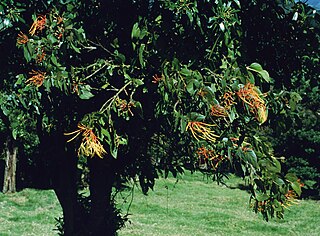
Psittacanthus schiedeanus G.Don is a species of Neotropical mistletoe in the family Loranthaceae, which is native to Panamá, Costa Rica, Honduras and Mexico.

Scaevola chamissoniana is a shrub in the family Goodeniaceae and its native range is the Hawaiian Islands, where it is known as the Mountain naupaka or Naupaka kuahiwi.
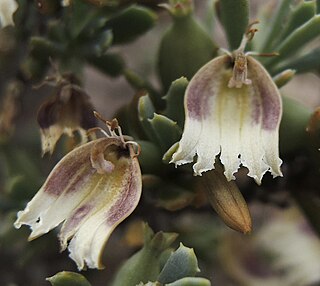
Scaevola collaris is a shrub in the family Goodeniaceae and its native range is five mainland states/territories of Australia: the Northern Territory, New South Wales, South Australia, Queensland and Western Australia.
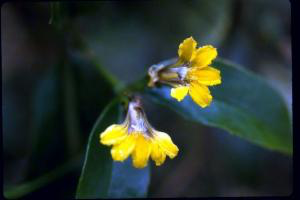
Scaevola enantophylla, commonly known as climbing fan-flower,is a species of flowering plant in the family Goodeniaceae and is endemic to Queensland. It is a scrambling vine with yellow fan-shaped flowers, and the only species in the genus with leaves arranged opposite.
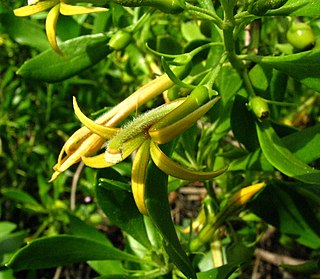
Scaevola gaudichaudii, the ridgetop naupaka, is a shrub in the family Goodeniaceae. The flowers are yellow. The plant is endemic to Hawaii.

Tupeia is a monotypic genus of semi-parasitic shrubs (mistletoes) which occurs in both the North and South Islands of New Zealand. There is only one species in the genus: Tupeia antarctica. There are no synonyms.

















